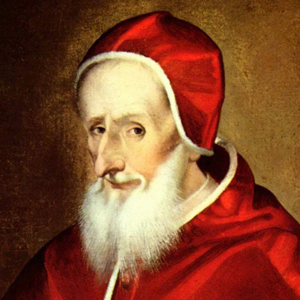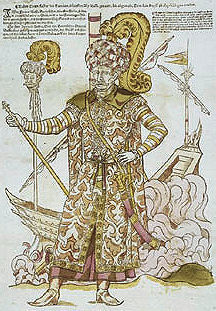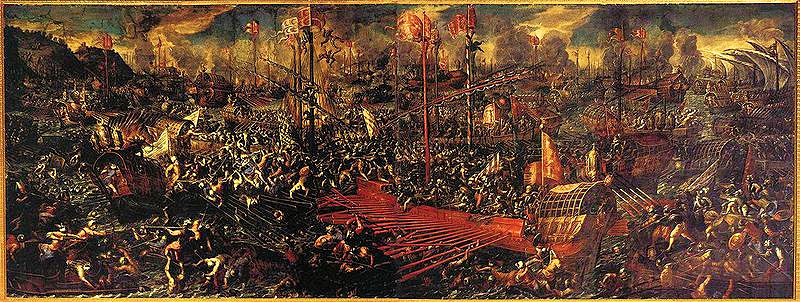The Feast of Our Lady of the Rosary
Here is but a small fraction of the victories directly obtained from God through the Holy Rosary:
- The Battle of Lepanto which saved Rome and Vienna, and thus the Pope and the Emperor, from Moslem subjugation
- The deliverance of Vienna by Sobieski
- The victory given to Prince Eugene of Peterwardein
- The raising of the siege of Corfu
- The taking of Belgrade
- The withdrawal from Soviet Troops from Austria on Oct. 26, 1955
- The deliverance of Brazil from Communism in 1964
In this article, we will focus only on the first on the list, that of the Battle of Lepanto.
The Battle of Lepanto, painting by Andries van Eertvelt
When Saint Pius V ascended the throne of Saint Peter early in 1566, Christendom faced extreme peril. The Huguenots had been waging a particularly violent war in France since 1562; the Spanish Netherlands exploded in revolt later in the year; England, having gone from schism to heresy, was openly assisting all the anti-Catholic forces; but the greatest danger came from the constricting tentacles of Muslim aggression throughout Europe and the Mediterranean.

Don Juan of Austria, the supreme commander of the Holy League against the Turks at the Battle of Lepanto.
The defense of Malta understandably raised Christian spirits, but it was only a defensive action. The powerful Ottoman fleet, still intact, continued to raid Christian lands. The year after that strategic triumph, Ali Pasha, who commanded the naval forces in Malta, captured Chios, the last Genoese position in the Eastern Mediterranean and through treachery murdered the ruling Giustiniani family. Then for three days the Mohammedans roved over the island, massacred all the inhabitants and destroyed everything Catholic. Two boys in the Giustiniani family, aged ten and twelve, were martyred. The younger boy, almost cut to pieces, was told to hold up one finger if he wished to apostatize and live. He clenched his fists so tight that they could not be opened even after death.
Some months later, Suleiman led another of those huge armies—always at his disposal—of 200,000 men and 300 cannons up the Danube River Valley toward Vienna. But instead of focusing on his main objective, he allowed himself to be distracted by a minor irritant in southwestern Hungary. The small, walled town of Szigetvar and its Croatian overlord, Count Zriny, who was cut from the same cloth as Skanderbeg, continued to resist occupation. Like most tyrants, Suleiman would not accept what he saw as insulting behavior and so deviated from his original plan. After losing several weeks just transporting his cumbersome equipment over difficult terrain, he was tied down another five weeks by the heroic resistance of the Hungarians. Zriny died leading a final charge with a sword in his hand and praise of Jesus on his lips. However, Suleiman could not enjoy any satisfaction from his misdirected effort, for he had died the night before. Vienna would have to wait for another day. Selim II, known as the Sot because of his drinking habits, took over the throne in Constantinople, having already eliminated all rivals in his family, and plotted the next attack on Christianity.
The Pope of the Rosary
Pope Saint Pius V by El Greco
From the moment of his elevation, Saint Pius V, through his experience and extraordinary vision, not only recognized the grave peril to Christendom but also saw the solution; the Ottoman power could be broken solely by means of a crusade; and crusades are won not only on the battlefield but also in the spiritual life, that is, on the supernatural level. Spain and Venice, as we shall see, viewed the Turks as a threat to their material welfare—as indeed they were—but the holy Pope also saw them as a threat to the order that God Himself placed in the world and for that reason employed the weapons of spiritual warfare.
Saint Pius V increasingly asked for more prayers from pious Catholics, especially from the monks and nuns in their cloisters. If he asked for more sacrifices from others, he certainly intended to carry his portion of the burden by doubling his accustomed exercises of piety and mortification. A devotion to which he gave special attention was the Rosary, so much so that he was called the “Pope of the Rosary.”(1) In fact, the great saint secured the uniformity of recitation of the Hail Mary through a Papal Bull published in 1568.
 Maps showing the positions of the Christians (red) and of the Turks (black) in the naval battle off the coast of Greece at 10:30 a.m. and noon.
Maps showing the positions of the Christians (red) and of the Turks (black) in the naval battle off the coast of Greece at 10:30 a.m. and noon.
The Holy League
While Saint Pius V was trying to organize an effective alliance against the increasing danger, another Muslim provocation illustrated the precarious situation. During the Christmas season of 1568, the pent-up hatred of the “converted” Moors, known as Moriscos, burst forth in all its massive cruelty. Savage tortures were employed against their victims before they were violently dispatched, especially against humble village priests and their altar boys. If they called on Jesus or His Blessed Mother for strength, their tongues were cut out or their mouths were loaded with gunpowder and ignited. These descendants of the invaders who had nearly destroyed Christian Spain during an occupation lasting eight centuries again drenched the country in blood.
Ferdinand Braudel in his acclaimed work on the Mediterranean(2) remarked that there was no doubt about the links between the Spanish rebels and the corsairs of Algeria, the latter being staunch allies of the Turks. The Barbary pirates brought men, ammunition, and weapons to the southern Spanish coast and took Christian prisoners as payment, thus introducing another thread in the noose strangling Catholic Europe.
Initial attempts to subdue the well-organized revolution met with failure until Don Juan of Austria was placed in overall command. A soldier who possessed all the extraordinary abilities of leadership, including judgment and courage, he vigorously and relentlessly pursued a campaign that destroyed the enemy strongholds and brought the survivors to their knees. Meanwhile, all the courts of Europe were informed that extensive preparations for greater aggression were visibly under way at Constantinople.
Naval battle of Lepanto by Andrea Micheli
Only a saint who lived daily in God’s presence and His benevolent power could have assessed the seemingly insurmountable difficulties of forming an anti-Turkish league and then going forward with such energy and tenacity.(3) Saint Pius V repeatedly sent out requests to the counts of Europe to join the crusade; yet, one treacherous or indifferent monarch after another excused himself. Spain, which could be motivated by Catholic considerations, and the Republic of Venice, whose territories were most vulnerable, did not refuse; nevertheless, they sent evasive replies.
Spain, alone among the Europeans, was willing to contribute its resources in men and material, although it had difficulty in seeing beyond its narrow interests. On the other hand, Venice, basically unreliable in any idealistic cause, was willing to fight only when its commercial interests were threatened. Yet Saint Pius V was finally able to bring the greatest power in Europe and the possessor of the largest fleet in the Mediterranean to the bargaining table.
Once there, the skillful and occasionally duplicitous negotiators, mutually distrustful and desirous of financial advantage, began to haggle over every possible issue. Throughout the long, agonizing months, the Pope’s overpowering personality swept aside all obstacles to force a decision. Although sick and in constant pain, the indomitable Pontiff finally concluded an agreement with the two shortsighted governments in March 1571.
According to the treaty, the choice of its supreme commander was reserved for the Pope. Behind his sumptuous chapel adorned with gold cloth and silver vessels was a bare, miserable oratory where the Dominican monk would go in the early morning hours to pray unobserved. Prostrated on the cold stones before a crucifix and with deep groans, the holy monk appealed to God for guidance. The Pope then went into the rich chapel to celebrate the Holy Sacrifice of the Mass. When he reached the Gospel of Saint John, he began to read, “Fuit homo missus a Deo, cui nomem erat Joannes!” (“There was a man from God whose name was John!”).(4) Turning his face toward the Virgin, he paused and realized that the commander of the crusade was to be Don Juan of Austria. The choice of this truly great crusader was of inestimable value, for the lack of competent leadership caused several scandalous failures during previous decades.
The Battle of Lepanto
In the middle of September, the largest Christian fleet ever assembled sailed out from Messina in Sicily to seek out and destroy the Muslim fleet commanded by the Sultan’s brother-in-law, Ali Pasha. Saint Pius V granted all members of the expedition the indulgences of crusaders. Not one of the 81,000 soldiers and sailors had failed to confess and receive Holy Communion.
 The immense fleet moved eastward across the Ionian Sea in a file stretching out for nearly ten miles. Ten days later it arrived at Corfu off the northwestern coast of Greece. The Turks had ravaged the place the month before and left their usual calling cards: burned-out churches, broken crucifixes, and mangled bodies of priests, women, and children.
The immense fleet moved eastward across the Ionian Sea in a file stretching out for nearly ten miles. Ten days later it arrived at Corfu off the northwestern coast of Greece. The Turks had ravaged the place the month before and left their usual calling cards: burned-out churches, broken crucifixes, and mangled bodies of priests, women, and children.
Here the animosity between the Italians and Spanish that festered just below the surface almost erupted when the Venetian commander, the crusty, battle-scarred old Sebastian Veniero, hung four argumentative Spaniards from his yardarm. Fortunately, cooler heads prevailed. Don Juan wondered if the Christians would annihilate one another before the enemy was even sighted.
Müezzinzade Ali Paşa, Turkish commander at the Battle of Lepanto
Then word arrived: “Ali Pasha is in Lepanto!” A long thin body of water, known as the Gulf of Corinth, separates central Greece from the Peloponnesus, the southern peninsula. About a quarter of the way into the inlet from the west sits Lepanto, the fortified headquarters of the Turkish fleet.
From Corfu the fleet worked its way down the northwest coast of Greece. On October 5 came the infuriating news that Christendom had suffered another cruel indignity from the Ottomans. Cyprus, the jewel of Venice’s far-flung island possessions, had been attacked the year before. The besieged capital, Nicosia, had fallen quickly, and its twenty thousand survivors had been massacred. The fortified city of Famagusta held out for another year due to the courageous leadership of Marc Antonio Bragadino, its governor. With no hope of relief in sight and starvation and disease reducing the population, Bragadino agreed to what appeared to be honorable terms and surrendered. In an act of unbelievable treachery, the Turkish general, three days later, hacked the Venetian officers to death. For the next week, Bragadino was horribly mutilated and then flayed alive.
At sunrise on Sunday morning, October 7, the chaplains on each ship were celebrating Mass as the vanguard of the fleet cruised south along the coast, turned the corner at the headlands, and entered the Gulf of Corinth. Since dawn the Turks had been moving in their direction from the east, with the advantage of having the wind at their back. While the ships of the League maneuvered from file to line abreast, Don Juan, with crucifix in hand, passed by each galley shouting encouragement and was met, as he made his way through the line, with tremendous applause and enthusiasm. By using tact and understanding, and forcefulness when necessary, he had welded many disparate elements into a united fleet.
Agostino Barbarigo
The young crusader divided his force into four squadrons. On the left, he placed the soft-spoken but fierce-fighting Venetian Agostino Barbarigo. Don Juan led the central squadron, ably supported by Veniero and the papal commander, Marc Antonio Colonna. The cautious Gian Andrea Doria controlled the fate of the right wing. Only the Christians displayed their forces in such a way as to create a reserve squadron, and they had the good fortune of having this under the command of the Marquis de Santa Cruz, the Holy League’s most respected admiral.
Although the Christian galleys were outnumbered, 274 to 208, they had superior firepower in cannon and harquebuses, while the Turks relied mostly on bows and arrows. By nine o’clock the two lines were fifteen miles apart and closing fast. Just before contact was made, the wind that had been favoring the Turks shifted around from the east to the opposite direction. The Christians drew first blood when their huge, though unwieldy, galleys fired many rounds of cannon shot with devastating effect. But because of their lack of maneuverability, the floating batteries quickly passed out of action.

Alvaro de Bazan, first Marquis de Santa Cruz, commander of the reserve squadron of the Holy League. Painting by Andrea F. Phillips
Barbarigo’s counterpart, Mohammed Sirocco, made a quick dash between the Venetian commander’s left wing and the shore line, hoping to swing around and trap Don Juan’s squadron from behind. Barbarigo quickly slid over and intercepted the Turks, but several galleys had slipped by and attacked him from the rear. When his squadron closed in to help, Barbarigo, standing in the midst of fierce struggle, lifted the visor of his helmet to coordinate their attack. An arrow pierced his eye; mortally wounded, he was carried below. However, his quick, self-sacrificing action had prevented Sirocco’s flanking movement. The Christian left then trapped the Muslim wing of fifty-six galleys against the shore and methodically destroyed it.
The center of both lines bore down heavily on each other without any thought of subterfuge or trickery. The Muslims were yelling, screaming, and banging anything that would make noise. The Christians were in an ominous silence, weapons in one hand, rosaries in the other. Usually, the flagships stand off from the heat of battle, but not this time; both supreme commanders set a hard course for each other. Ali Pasha’s Sultana gained the initial advantage by ramming into the Reale up to the fourth rower’s bench. Don Juan grappled the two ships together and boarded. Instantly, a dozen Turkish ships closed in behind Ali Pasha, supplying him with thousands of janissaries. Veniero and Colonna hugged the Reale from either side. Reinforcements arrived from other galleys. Some two dozen ships became interlocked, thus forming a floating battlefield. The battle raged back and forth over the blood-soaked, carnage-strewn decks.
Many in the Christian fleet performed magnificent acts of valor. The ferocious old Veniero stood at his prow in full view, firing shot after shot while his young servant reloaded. A Sicilian sergeant, rather than die of disease, jumped out of his sickbed, went on deck, and killed four Turks before dying from nine arrow wounds. The duke of Parma, companion to Don Juan and future military genius, jumped aboard a Muslim galley and cut down the first twelve men he faced.
Finally, Don Juan, huge broadsword in one hand and an axe in the other, led an attack across the Sultana that ended in the death of Ali Pasha. From that point on the spirit and fighting capacity of the Turks declined.
Battle of Lepanto by Andrea Vicentino, Oil on canvas, Palazzo Ducale, Venice
One last hope for the Ottomans remained. Aluch Ali, the clever Barbary corsair, out-foxed Doria by dragging him too far to the Christian right. He then cut back and slipped through the opened hole. Cardona, with a handful of galleys, attempted to block him but was wiped out. Santa Cruz, who was giving valuable support to the center squadron, broke away to intercept Aluch Ali. The latter, seeing his opportunity for an unhindered attack on the Christian rear disappear, fled to the open sea with just a few of his ships. Most of his squadron was destroyed when Doria wheeled about and assisted Santa Cruz in finishing the weakened Ottoman fleet.
The Holy League had achieved an overwhelming victory in the largest sea battle fought up to that time. The Ottoman Empire lost about 240 galleys and saw 30,000 killed. The League suffered a trifling 12 galleys sunk; 7,600 men were killed.
At the time the battle was won, Saint Pius V was studying financial sheets with the papal treasurer. He rose, went to the window and looked toward the east. When he turned around his face was radiant with supernatural joy, and he exclaimed, “The Christian fleet is victorious!”(5)After human agencies verified the news two weeks later, Saint Pius V added the Feast of the Holy Rosary to the Church calendar and the invocation Auxilium Christianorum to the litany of Our Lady, since the victory was due to her intercession.
by Jeremias Wells
Short Stories on Honor, Chivalry, and the World of Nobility—no. 323
Notes:
1. C. M. Antony, Saint Pius V: Pope of the Rosary (New York: 1911), 77.
2. Ferdinand Braudel, The Mediterranean (New York: 1973), 1061.
3. For a complete and accurate account of the difficulties, see Ludwig von Pastor, History of the Popes (St. Louis, Mo.: 1929), vol. XVIII.
4. Father Luis Coloma, Story of Don John of Austria (London: 1913), 215.
5. Robin Anderson, Saint Pius V (Rockford, Ill.: 1978), 78. Several biographers use a longer quotation. See Antony, op. cit., 91.
____________________
Also of interest:
Statue of the Blessed Virgin present at the battle of Lepanto has been found
The martial and pious death of Don John of Austria: “A man sent by God”
Tunis was lost because Don John could not reach it in time
Don John called his lion Austria
Don John is offered the kingdoms of Albania and Morea
Fatima Cadem, daughter of Ali Pasha, asks Don John to release her captured brothers
Pope Saint Pius V has a vision announcing the victory of Lepanto
Don John of Austria used an ivory crucifix to inspire his men before Lepanto
Don John of Austria’s calm self-command seeing the power of the Turkish armada








No comments:
Post a Comment